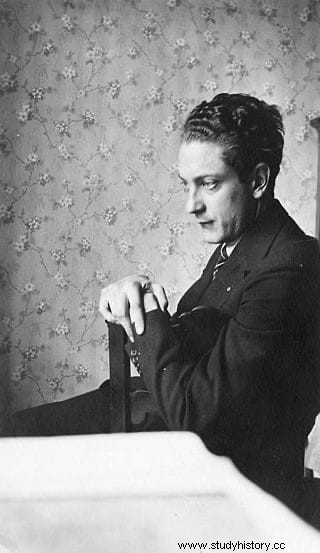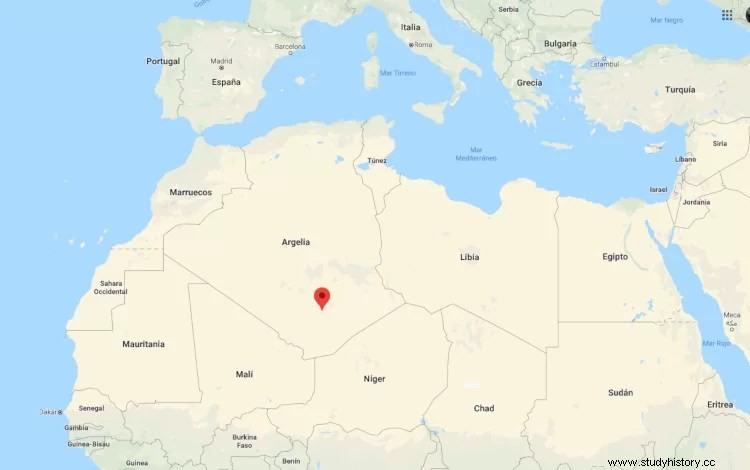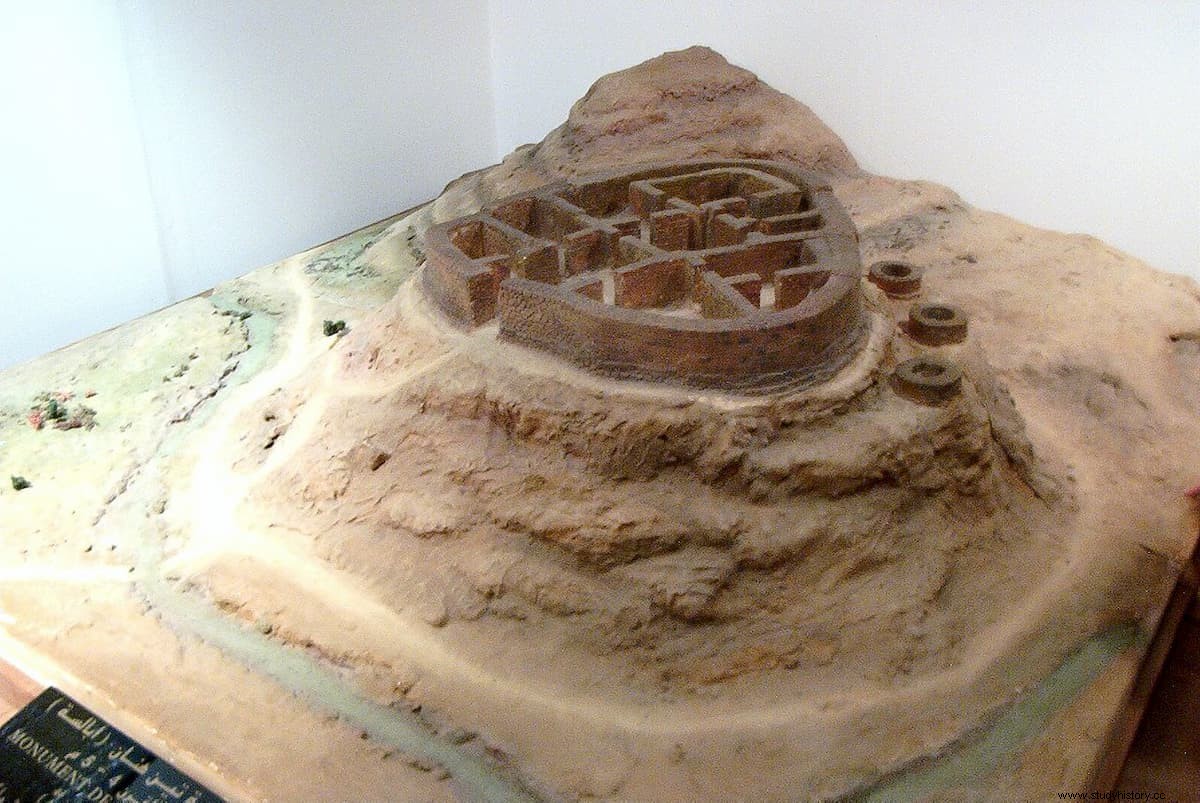In the fall of 1925, the adventurer Byron Khun of Prorok and his team located a 4th-century burial in the municipality of Abalessa, in the interior of present-day Algeria. It was the tomb of Tin Hinan, a matriarch warrior queen of the Tuareg who was spoken of by legends without it being clear whether she was a real or mythical character. The discovery and its corresponding excavation seemed to prove its existence and marked a new milestone in archaeology, just three years after Howard Carter made history by finding Tutankhamun's hypogeum.
Byron Khun de Prorok was an American born in Philadelphia in 1896, a peculiar type, without too many scruples, who called himself a count without being one, just as he passed as an archaeologist despite not having completed studies. In fact, he was accused of being a freeloader who organized expeditions without scientific value, such as the one he made to North Africa in search of Atlantis, the biblical land of Ophir or the temple where Alexander the Great became a god, all of them with success according to himself.
Likewise, he claimed to be a member of the Order of the Holy Sepulcher, the Royal Archaeological Institute and the Royal Geographic Society (he would be expelled from it in 1932 or so he said), but the only evidence is that he belonged to the Adventurer's Club of New York.

It is true that not everything in his life is so suspicious, since it is known that he studied at the University of Geneva and that he participated in the excavations of Carthage between 1920 and 1925, the latter activity that he combined with his work as a reader for the Archaeological Institute of America from 1922 to 1923. However, he was negatively valued by all his professional colleagues, who considered him a simple looter, interested only in the treasures they contained, destroying the rest to get them. Despite everything, he managed to finance what would be the expedition that would make him enter history.
His objective was the Algerian Sahara, where he hoped to find the inhabitants of the Ahaggar mountains, an orogenic massif located in the province of Tamanrasset where «a mysterious people lived, tall, straight and thin, who consider themselves as the greatest of all races and similar to the Egyptians depicted in the ancient tombs of the pharaohs» . He was referring to the Imuhagh, a name given to themselves by the Tuareg, members of the Kel Ahaggar, a confederation of tribes that included the Kel Rela, Aït Loaien, Dag Rali, Kel Silet, Taituq and Tégéhé Millet, to cite the most important, under the direction of an elected common chief who bore the title of amenokal .
This confederation existed since its official foundation in 1750, although its roots sank much further back in time, in Antiquity. In the background in Prorok's head was the medieval legend of Prester John, a supposed Christian ruler in a land of pagans and infidels, a descendant of the Magi and whose kingdom was very prosperous, as the possible origin of a Libyan-Phoenician civilization from which there were supposed to be remains and buried ruins. His descendants would be the Tuareg, "strange people" In the words of the American adventurer, who was struck by the fact that they were light-skinned people who were very jealous of his domain.
A priori It sounds crazy and the cast of collaborators he surrounded himself with was consistent with that image. There was an archaeologist from the Logan Museum of Anthropology in Wisconsin, Alonzo W. Pond (with whom he inevitably ended up clashing), but the others were the French administrator Maurice Reygasse, the hunter W. Bradley Tyrrell, a journalist fromThe New York Times named Harold Denny and the film and photography operator Henry Barth (Prorok was a pioneer in using films, although unfortunately none have been preserved), as well as the guide Louis Chapuis, an interpreter, two other native guides and a cook who is also indigenous. All of them, together with some auxiliaries and the help of the French army, left Algiers aboard three Renault motorized vehicles in October 1925.

That same month they reached Touggurt and entered the unknown through El Kantara, a city nicknamed the Mouth of the Desert (the Romans called him Calceus Herculis , Zapato de Hércules), because it has a narrow gorge no more than forty meters wide whose walls rise up to one hundred and twenty meters and, as its name indicates, it is the door that must be crossed to access the vast Saharan territory. Ahead, more than three thousand kilometers of sand and suffocating heat awaited them. Quite an adventure, without a doubt, regardless of the seriousness of the objectives it had. In fact, there were difficult moments, like when they got lost in the dunes once they left Ouargla behind and needed the help of the French.
Thus they reached the oasis of In Salah, which was a crossroads for the trans-Saharan caravan routes and was considered the last station of civilization . The next stage was to Tamanrasset, another oasis that the Algerian Tuareg considered as a kind of capital, where they were received by the amenokal Akhamouk ag Ihemma, leader of all the Tuareg chiefs in the region for five years and liaison with the French colonial administration. There they also learned that a force of 500 rebels from southern Morocco was moving towards the Ahaggar mountains and had narrowly missed it.
Prorok decided to split his group in two:Pond, Reygasse, and Akhamouk would head north to study and document Tuareg customs, while he and the others went south to search for a vast pyramidal mound said to be in the ridge. , surrounded by peaks of two thousand meters of altitude. He expected it to be the Tin Hinan burial mound, a name translatable as She of the Shops (unequivocal reference to her nomadism, as we will see) but that was later adapted to Mother of all because she would have been the first to promote the union of the Tuareg tribes, which would later materialize fully in the aforementioned Kel Ahaggar.
On October 18, 1925, they found the exact site in the village of Abalessa, the ancient capital of Ahaggar. As Prorok would explain, the finding required several days because the Tuareg, suspecting what the objective was, were reluctant to collaborate and tried to divert attention. However, it seems that the sub-Saharans did agree and they were the ones who indicated the point where to dig:a rounded hill of about thirty-eight meters located at the point of union of two boulevards.

The tomb, with a pear-shaped plan and divided into eleven chambers that formed a small de facto necropolis , was reasonably preserved on its northern part, with an intact wall about seven meters high that revealed the architectural technique used; instead, the roof had collapsed. The complex measured about eighteen by twenty-seven meters in area, with walls a meter thick except in the smallest tombs, where they were less than half a meter. Some walls featured inscriptions in tifinag, a consonantal alphabet of the Berber language that was used from the 3rd century BC. throughout North Africa, the Canary Islands included.
Shortly after the work began, one of those things happened that seems to come from the mind of a writer or a filmmaker:a strong sandstorm broke out that terrified the natives and not only made them flee but also refused to return, which which forced the hiring of a new staff. Finally, after two weeks of clearing debris, Prorok managed to access the interior to find several skeletons of children and a larger one, female, lying on her back in a wooden sarcophagus, wrapped in bandages and with her head facing east. She had seven gold bracelets on her right forearm and seven silver bracelets on her left, as well as five pearl necklaces and other jewelry (bracelets, rings...) set with precious stones.
But there was also a trousseau that was just as amazing or more:the stone statuette of a venus similar to the prehistoric ones, a glass goblet, various funerary objects, a knife and iron arrowheads. Also a hexagonal gold leaf with the seal of a Roman coin of Constantine the Great , which therefore would have been minted between the years 308 and 324 AD. The latter served to date the tomb, something that would later be corroborated with the carbon-14 analysis of the wood of the sarcophagus and some furniture taken from other nearby tombs; it also matched the style of recovered pottery pieces, including a 3rd century AD Roman lantern

The bones needed to be analyzed. Due to the ornaments, Prorok identified them as women's and the rich trousseau also indicated that he was of high class, all of which excited him because it pointed to Tin Hinan and thus its historical existence would be demonstrated, surpassing its consideration of mere legend. And it is that the mother of all of us , which is more or less what her name properly adapted from her means, she was originally from a Berber tribe from Tafilete, an oasis in the Atlas Mountains (in what is now Morocco). And she, yes, she lived in the fourth century AD.
She was a fugitive princess of whom it is not known if she was fleeing -on a white camel, according to tradition- from a raid that ended her family or from an arranged marriage. She accompanied by her daughter (or her granddaughter) Kella and a servant named Takamat , who also had two daughters, she led a caravan of faithful on a pilgrimage through those difficult lands over a thousand four hundred kilometers, although how long it took them to travel is unknown. In any case, it must not have been comfortable and they were about to perish of starvation and thirst until, finally, in the Abalessa valley, they were able to recover in a wonderfully poetic way:eating the grain that the ants kept in their enormous termite mounds . From there, she managed to unify the sedentary clans of the region and turn them into nomads.
In reality, as often happens, there are several versions of the myth and in another Tin Hinan would engender three more offspring, each with the totemic name of a desert animal (Tiner, Takenkor and Tamerouelt), who would be the founders of as many Tuareg tribes. of Ahaggar (the descent there is done matrilineally). That second version makes Tin Hinan Muslim, which is impossible given that Muhammad was not born until the 6th century AD. Of course, Kella is also anachronistic; there was a historical character with that name but she lived in the 17th century. Three years earlier, the Tunisian historian Ibn Jaldún (whose family was Andalusian, from Seville) collected one more legend that for many researchers would be better adjusted to reality as it coincides with the archaeological record:that of the lame queen Tiski, matriarch of the tribes of the Ahaggar mountains. Because current studies seem to indicate that the tomb is just another burial like others in the region.
Prorok accumulated a multitude of criticisms, even from his own companions, because of his eagerness to make his way into the tumulus from the top, which Chapuis was able to prevent him by convincing him to do so in a canonical way, by means of a transversal trench. They also accused him of being interested only in the treasure, of giving a fanciful chronology (later it turned out that he had been right) and even of falsifying the discovery by adding pieces that were not originally there. It is difficult to clarify the facts because, despite local protests, the expedition transferred everything found to the National Museum of Prehistory and Ethnography of Bardo, in Algiers... except for a part that Prorok decided to take with him (a gold pendant, several precious stones , the venus and the skull of Tin Hinan), causing an international scandal.
He was harshly criticized for that and because it was discovered that the forty-six boxes of material that he claimed to have collected, and that took forever to reach the Algerian capital because they were riding camels, did not really exist; they were an exaggeration of his to attract the attention of the international press. The discovery of the burial mound was an archaeological milestone but cunningly magnified. Unable to discourage, Prorok would return to his old ways soon after embarking on an expedition to Abyssinia (Ethiopia) in search of King Solomon's mines. Of course, he claimed to have found some of whose existence he never presented more proof than his account.
Maurice Reygasse returned to Abalessa in 1933 to study the remains of the burial and proposed that it had previously been a redoubt of Roman legionnaires - he even called it a kasbah – later reused as a tomb. Now then, the matter of Tin Hinan was not over yet. An anthropological study carried out in 1935 confirmed that the remains corresponded to a middle-aged Libyan female, one meter seventy-five tall. However, another from 1968 concluded that it was male. Even today the controversy continues but there is a unanimous and significant fact:the pelvis of the skeleton is too small, hence today it is attributed to a man; and if it were a woman, he would never have been able to have children. The Tuareg, of course, don't care; they continue to believe in their founding myth.
